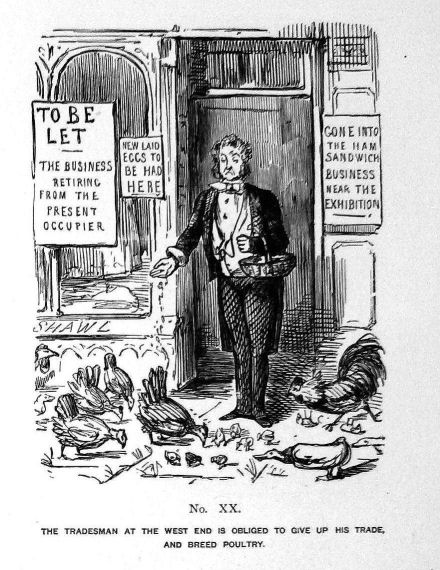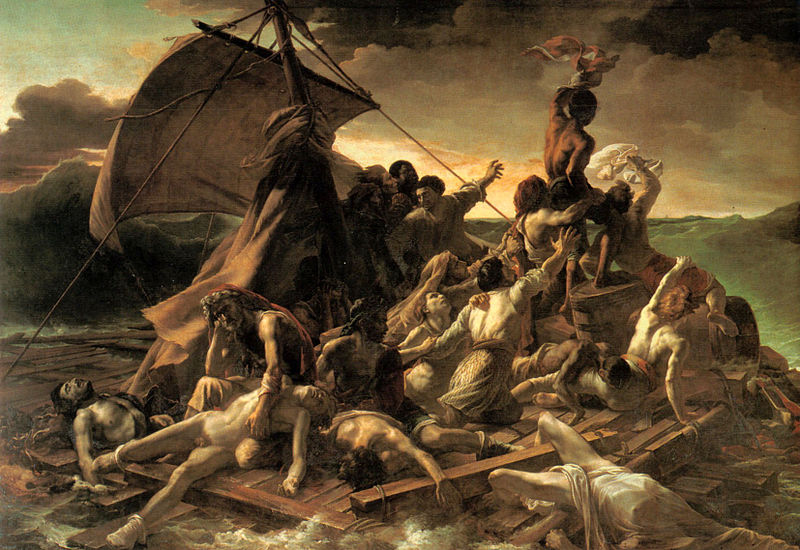Punch was a British weekly magazine of humor and satire established in 1841 by Henry Mayhew and Ebenezer Landells. Reflecting this satiric and humorous intent, the name Punch refers to the anarchic puppet, Punch, of Punch and Judy. It was Punch that not only helped to the coin the term "cartoon" in the modern sense of a humorous illustration, but also coined the term "the Crystal Palace" in reference to Paxton's huge exhibition building in Hyde Park. The magazine provided a weekly satirical glance at the week's news events, its irreverence for British institutions appealing to the rapidly expanding middle classes.
Punch produced a series of articles and visual caricatures on the Great Exhibition that by turn satirized and praised the Great Exhibition in response to changing public opinion on the Exhibition. Punch's commentary on the Great Exhibition is interesting because, in contrast to many newspapers that documented the objects displayed at the Exhibition in great detail, it focused very much on the people who visited or "occupy[ed] other relationships to the Exhibition (cabbies, shopkeepers, the police)"[1]. Virtually the only exhibits to be represented in Punch during the period of the Exhibition were the koh-i-noor diamond and the statue of an Amazon, and even then only to signify "racial, social and gendered meanings"[2].
Contemporary issues
In its approach to the Great Exhibition, Punch picked up on a number of issues and tensions in mid nineteenth century England.
A first example can be seen in "Specimens from Mr Punch's Industrial Exhibition of 1850", which displayed workers in a glass case including "A Labourer aged 75" and "A Distressed Shoemaker".
"Specimens from Mr Punch's Industrial Exhibition of 1850" (to be improved in 1851), published in Punch 18 (1850) Pg 145
The cartoon picked up on class tensions in society, heightened by the Chartist riots and European revolutions of 1848, and caricatured by the corpulent figure of Mr Punch in comparison to emaciated workers. Punch also criticized the Exhibition's perceived preoccupation with foreign industry at the cost of local trade. A full page of cartoons, below, entitled "The Workings of the Great Exhibition", satirized the plight of small businessmen, the manager of a theatre forced to close through a lack of ticket sales, for example, and the folly of others including “the British Merchant, taking leave of his senses – and his business”, off to “lounge about the Crystal Palace .”
"Workings of the Great Exhibition", published in Punch, 1851
One of the "Workings of the Great Exhibition" cartoons, entitled "The Tradesmen at the West End is obliged to give up his trade and breed poultry"
A third target of Punch's satire was the use of the Great Exhibition by Parliament as a distraction from the troubles of the country.
Above: The Raft of the Medusa, Theodore Gericault, 1818-1819, the painting on which "The Shipwrecked Ministers saved by the Great Exhibition steamer" cartoon was based.
Left: "The Shipwrecked Ministers saved by the Great Exhibition steamer" by John Leech, published in Punch 20, 1851.
“The Shipwrecked Ministers saved by the Great Exhibition Steamer,” was published in Punch in 1851 and is based on a painting by Gericault, The Raft of Medusa. Gericault's painting is a haunting depiction of the survivors of a ship thought to be shipwrecked by the neglect of the captain. The Ministers in Punch’s cartoon, meanwhile, similarly huddled together on a make-shift raft, look on at the wreckage of the cabinet ship, whilst Lord John Russell waves frantically at a passing ship for rescue, the "Exhibition Steamer" which will raise the popularity of a defeated and helpless government.
Society at the Great Exhibition
Punch's other main focus of satire was the attitudes of the working, middle and upper classes to the Exhibition and their interaction with each other at the Exhibition. The middle class were deemed to have superficial reasons for visiting the Exhibition whereas the working class went to improve their education. Thus "The Looking Glass Department" caricatures middle class self absorption as ladies preen themselves in a series of mirrors in one of the Exhibition's salons, a neat illustration of Punch's acid observation that "the high-paying portion of the public go to look at each other and be looked at, while the shilling visitors go to gain instruction from what they see"[3].
"The Looking-Glass Department", published in Punch's Almanac for 1851, 20 1851. Pg ix.
Through "The Pound and the Shilling" (below), Punch highlights another much commented on aspect of the Great Exhibition, the substantial social mixing at the Great Exhibition at a time characterized by social segregation. Here, John Leech's engraving depicts the Duke of Wellington and some well dressed ladies, face to face with a working man in a stocking cap and his poorly dressed children.
Punch cartoons of the Great Exhibition, then, provide a valuable insight into Victorian society, into its norms, outlook and contemporary issues of debate. The Great Exhibition provided a microcosm of Victorian society which Punch was quick to observe and exploit.
__________________Notes:
[1] "Thackeray and Punch at the Great Exhibition: authority and ambivalence in verbal and visual caricatures", Richard Pearson in The Great Exhibition of 1851: new interdisciplinary essays, Louise Purbrick, ed. (Manchester University Press, 2001) Pg 181.
[2] Ibid
[3] "The Shilling days at the Crystal Palace", Punch 20, 1851. Pg 240







No comments:
Post a Comment